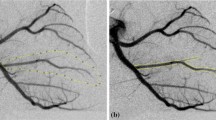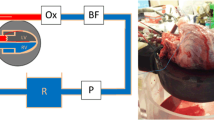Summary
The purpose of this study was to develop a technique measuring the perfusion area of the coronary artery preocclusively and to study the relationship between the perfusion are aand infarct size.125I tracer microspheres were selectively injected into the left circumflex coronary artery (LCX) preocclusively, and then the LCX was ligated 48 hours later the heart was removed, rapidly frozen, and 50-μ transverse sections were obtained from base, middle and apex of the canine left ventricle, and used for autoradiography to measure perfusion area and for tetrazolium staining to measure infarct size. Dogs were divided into 2 groups: group 1 in which the main trunk of the LCX was occluded to produce large infarct (n=10) and group 2 in which the distal branch of the LCX was occluded to produce small infarct (n=10). There was a linear correlation between the perfused and infarcted area regardless of a size or location of the perfusion area involved. These results indicate that the extent of infarction is directly proportional to the perfusion area and is not altered by the location in the ventricle.
Similar content being viewed by others

References
Maroko, P. R., E. Braunwald: Modification of myocardial infarction size after coronary occlusion. Ann. Int. Med.79, 720 (1973).
Sobel, B. E., G. F. Bresnahan, W. E. Shell: Estimation of infarct size in man and its relation to prognosis. Circulation46, 640 (1972).
Maroko, P. R., J. K. Kjekshus, B. E. Sobel, T. Watanabe, J. W. Covell, J. Ross Jr., E. Braunwald: Factors influencing infarct size following experimental coronary occlusion. Circulation43, 67 (1971).
Nakamura, M., Y. Kikuchi, Y. Senda, A. Yamada, Y. Koiwaya: Myocardial blood flow following experimental coronary occlusion: Effects of diltiazem. Chest78, 205 (1980).
Nakamura, M., Y. Hirosawa: Symposium on myocardial ischemia. Jap. Circul. J.44, 179 (1980).
Schaper, W., P. Remijsen, R. Zhonneux: The size of myocardial infarction after experimental coronary artery ligation. Kreislaufforschg.58, 904 (1969).
Keith, A., K. A. Reimer, B. Robert, R. B. Jennings: The ‘wavefront phenomenon’ of myocardial ischemic cell death. II. Transmural progression of necrosis within the framework of ischemic bed size (myocardium at risk) and collateral flow. Lab. Invest.40, 633 (1979).
Jugdutt, B. I., G. M. Hitchins, B. H. Bulkley, L. C. Becker: Myocardial infarction in the conscious dog: three dimensional mapping of infarct, collateral flow and region at risk. Circulation60, 1141 (1979).
Kloner, R. A., C. E. Ganote, R. B. Jennings: The ‘no reflow’ phenomenon after temporary coronary occlusion in the og. J. Clin. Invest.54, 1496 (1974).
Folts, J. D., E. B. Crowell, Jr., G. G. Rowe: Platelet aggregation in partially obstructed vessels and its elimination with aspirin. Circulation54, 365 (1976).
Nachlas, M. M., T. K. Schnitka: Macroscopic identification of early myocardial infarcts by alterations in dehydrogenase activity. Amer. J. Pathol.42, 379 (1963).
Lowe, J. E., K. A. Reimer, R. B. Jennings: Experimental infarct size as a function of the amount of myocardium at risk. Amer. J. Pathol.90, 363 (1978).
Hirzel, H. O., E. H. Sonnenblick, E. S. Kirk: Absence of a lateral border zone of intermediate creatine phosphokinase depletion surrounding a central infarct 24 hours after acute coronary occlusion in the dog. Circulat. Res.41, 673 (1977).
Simson, M. B., W. Harden, C. Barlow, A. H. Harken: Visualization of the distance between perfusion and anoxia along an ischemic border. Circulation60, 1151 (1979).
Harken, A. H., C. H. Barlow, W. R. Harden, B. Chance: Two and three dimensional display of myocardial ischemic ‘border zone’ in dogs. Amer. J. Cardiol.42, 954 (1978).
Author information
Authors and Affiliations
Additional information
This project was supported by Grant-in-Aid for Scientific Research (Nos. 344044 and 544049), Encouragement of Young Scientists (No. 477399) and Special Project Research (No. 412009) from Ministry of Education, Science and Culture, Japan.
Rights and permissions
About this article
Cite this article
Nakamura, M., Tomoike, H., Sakai, K. et al. Linear relationship between perfusion area and infarct size. Basic Res Cardiol 76, 438–442 (1981). https://doi.org/10.1007/BF01908338
Issue Date:
DOI: https://doi.org/10.1007/BF01908338



